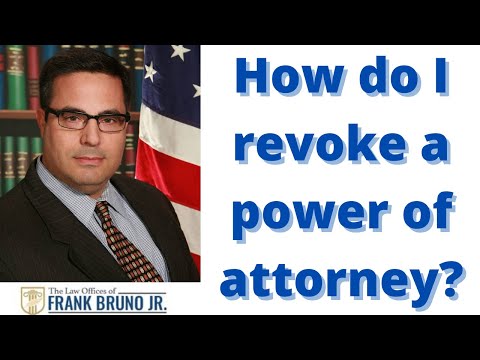
Welcome to this informative article on the process of canceling a Power of Attorney in the United States. We understand that navigating the legal landscape can be complex, and we aim to provide you with a comprehensive guide that will shed light on this topic. However, it is important to note that while we strive to offer accurate and up-to-date information, it is always advisable to cross-reference with other reputable sources or consult with legal advisors to ensure you are making informed decisions. With that in mind, let’s delve into the process of canceling a Power of Attorney in the United States.
Canceling Power of Attorney in the United States: A Step-by-Step Guide
Canceling Power of Attorney in the United States: A Step-by-Step Guide
Introduction
📋 Content in this article
When granting someone a power of attorney, you are giving them the authority to make decisions on your behalf. However, there may come a time when you no longer want or need that person to have that power. In such cases, it is important to understand the process of canceling a power of attorney in the United States. This comprehensive guide will walk you through the necessary steps to terminate a power of attorney arrangement.
Step 1: Review the Power of Attorney Document
The first step in canceling a power of attorney is to carefully review the original document. This legal document outlines the scope of authority granted to the agent (the person appointed with power of attorney) and any conditions or limitations that may apply. Understanding the terms and conditions of your power of attorney is crucial as it will dictate how you can proceed with cancellation.
Step 2: Determine the Type of Power of Attorney
There are different types of power of attorney, each with its own rules and requirements for cancellation. The most common types include general power of attorney, durable power of attorney, and springing power of attorney. General power of attorney gives broad authority to the agent and is typically terminated upon the principal’s incapacitation or death. Durable power of attorney, on the other hand, remains in effect even if the principal becomes incapacitated. Springing power of attorney only becomes effective under specific conditions outlined in the document. Understanding the type of power of attorney you have will help you navigate the cancellation process.
Step 3: Determine Reason for Cancellation
Before proceeding with canceling a power of attorney, it is important to determine your reasons for doing so. Common reasons include:
Understanding the Latest Developments in Power of Attorney Judgments in US Law
Understanding the Latest Developments in Power of Attorney Judgments in US Law
In the United States, a power of attorney is a legal document that grants someone else the authority to make decisions on your behalf. This document can be used for various purposes, such as managing financial affairs, making healthcare decisions, or handling real estate transactions. However, recent developments in US law have brought about changes in the process of canceling a power of attorney. In this comprehensive guide, we will walk you through the steps involved in canceling a power of attorney and provide important insights into the latest developments in power of attorney judgments.
The Process of Canceling a Power of Attorney
Canceling a power of attorney involves several important steps to ensure its validity and to protect your interests. It is crucial to understand these steps to navigate the process smoothly. Here is a comprehensive guide:
The Process of Canceling a Power of Attorney in the United States: A Comprehensive Guide
Introduction:
In the United States, a Power of Attorney (POA) is a legal document that grants someone else the authority to act on your behalf in various matters. It is an important tool that can be used for financial, medical, or other personal affairs. However, there may come a time when you need to cancel or revoke a POA due to changed circumstances or the need for a different representative. This guide will provide you with a comprehensive overview of the process of canceling a Power of Attorney in the United States.
Importance of Staying Current:
The laws governing the cancellation or revocation of a Power of Attorney can vary from state to state in the United States. Therefore, it is crucial to stay current on the specific laws and regulations in your jurisdiction. This article serves as a general guide, but it is essential to verify and cross-reference the information with local statutes, legal professionals, or government agencies.
Understanding the Power of Attorney:
Before delving into the process of canceling a Power of Attorney, it is essential to have a clear understanding of what it entails. A Power of Attorney is a legal document that grants another person (known as an agent or attorney-in-fact) the authority to act on behalf of the principal. The principal is the person who creates and signs the POA.
Types of Power of Attorney:
There are different types of Power of Attorney documents, including General, Limited, Durable, and Springing. The cancellation process may vary depending on the type of POA you wish to revoke. Each type grants different levels of authority to the designated agent.
Process for Canceling a Power of Attorney:
1. Review the POA Document:
Begin by carefully reviewing the original Power of Attorney document you wish to cancel. Look for any provisions related to cancellation or revocation. Some POAs contain specific instructions on how to terminate the document.
2.
